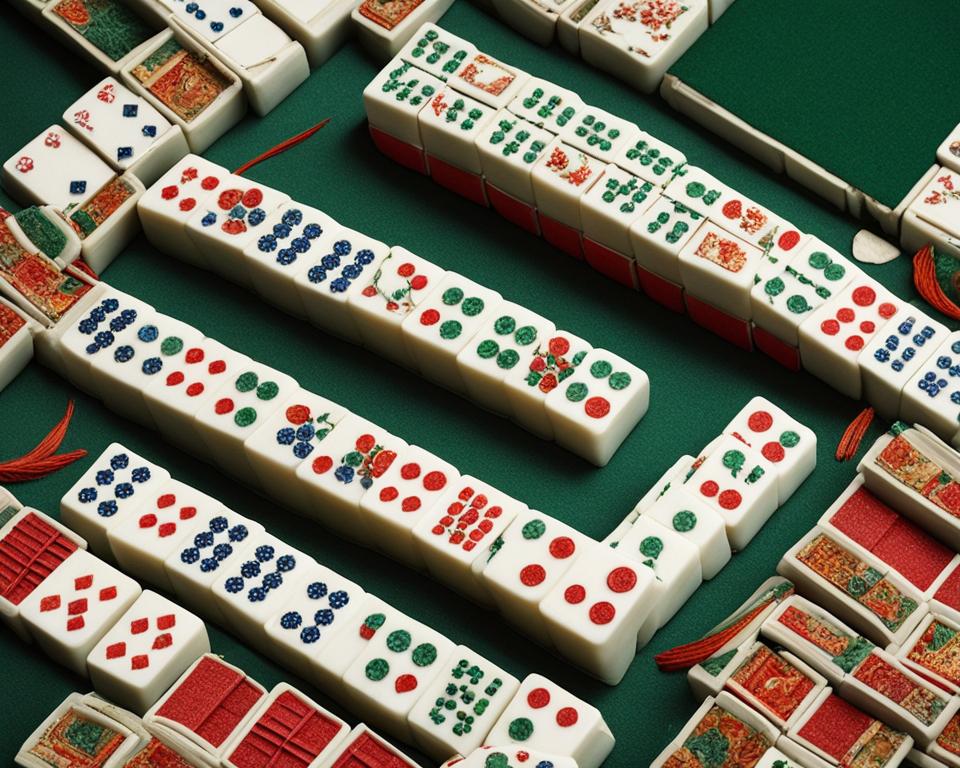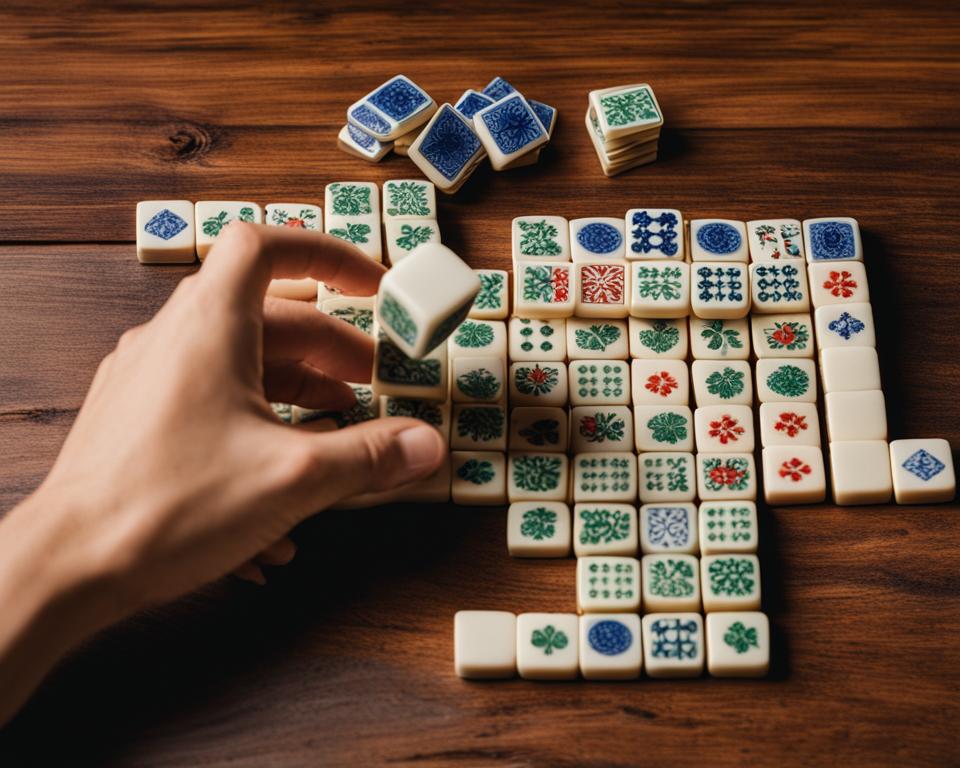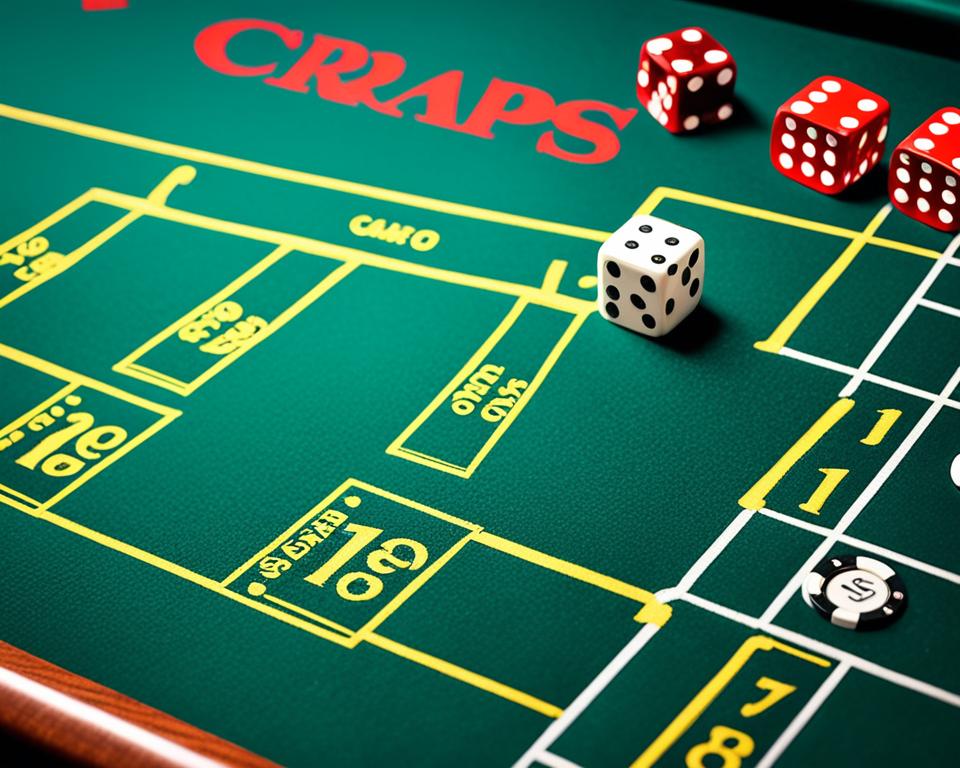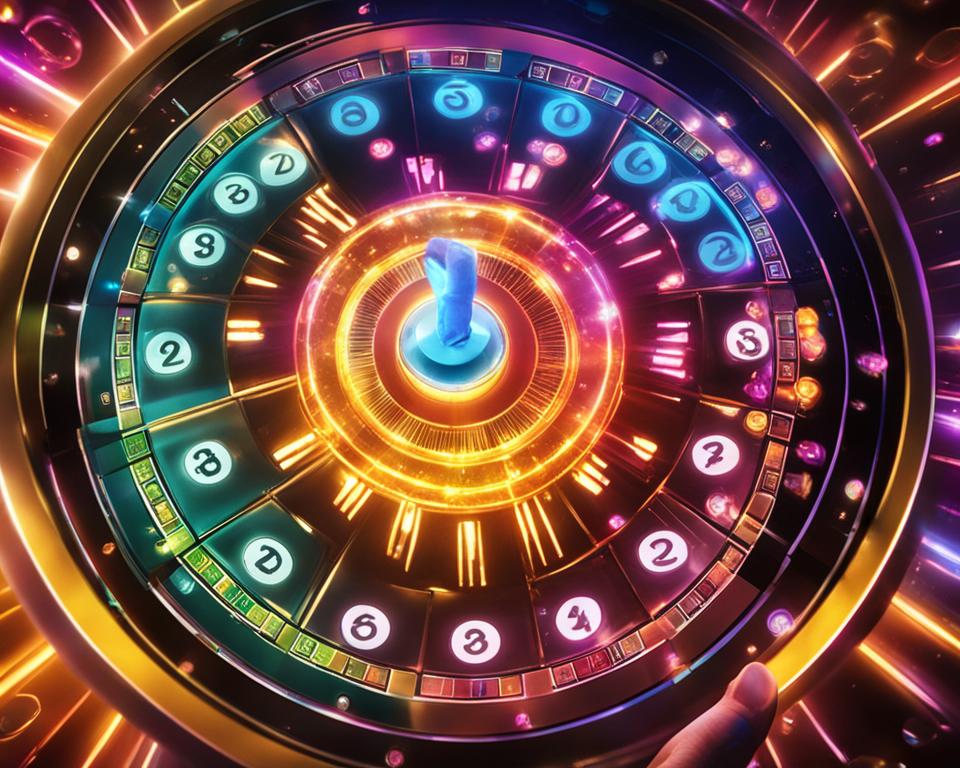Welcome to “Mahjong Mastery for Beginners: Tips & Strategies.” In this article, we will guide you through various strategies to help you master the game of Mahjong and improve your chances of winning. Whether you’re new to Mahjong or looking to enhance your skills, these tips and techniques will provide valuable insights applicable to all styles of Mahjong, with a focus on American Mahjong. We have gathered expert advice from experienced players to cover tile organization, game phases, joker usage, hand reading, and more. Let’s dive in!
Key Takeaways:
- Organize your tiles efficiently by sorting them in numerical order and by suits.
- Pay attention to the tiles being passed in the Charleston phase to adjust your strategy accordingly.
- Be flexible in your gameplay and ready to switch hands based on discards and exposures from other players.
- Utilize jokers strategically to complete winning combinations and increase your chances of success.
- Practice reading Mahjong hands and learn to recognize different hand patterns to better understand your opponents’ strategies.
General Advice for Mahjong Mastery
Being prepared is key to successfully playing Mahjong. Whether you’re a beginner or looking to improve your skills, here are some general tips and advice to help you on your journey to Mahjong mastery.
1. Familiarize Yourself with the Current Year’s Card
Each year, a new Mahjong card is released, featuring various hand patterns and winning combinations. Take the time to study the card and make notes of the patterns and potential hands you can aim for. By understanding the card, you’ll have a better idea of the objectives and strategies that can lead you to victory.
2. Be Patient and Observant
Mahjong is a game of patience and observation. Take your time to assess the tiles on the table, the discards from other players, and the potential hands within your reach. Being observant allows you to make informed decisions and adjust your strategy accordingly.
3. Be Flexible and Defensive
Flexibility is key in Mahjong. Don’t get fixated on a single hand. Be open to switching strategies based on the tiles and information available. Additionally, adopt a defensive mindset to prevent others from winning. Be cautious of discarding tiles that may benefit your opponents and aim to disrupt their plans whenever possible.
4. Develop Quick Decision-Making Skills
Mahjong requires quick decision-making skills. Analyze the options available to you, evaluate the risks and rewards of each decision, and make your move confidently. Practice thinking on your feet to stay one step ahead of your opponents.
5. Rack Your Tiles Efficiently
Efficient tile organization is crucial in Mahjong. Keep your tiles neatly arranged on your rack, making it easier to see and assess your options. Consider sorting them by numerical order and suit, and separate special tiles such as flowers, dragons, winds, and jokers for quick identification and strategic placement.
6. Pay Attention to the Charleston and Discards
The Charleston phase of Mahjong involves passing tiles between players. Pay close attention to the tiles being passed and the discards made by other players. This information can give you insights into their potential hands and help you adjust your strategy accordingly.
7. Learn Your Opponents’ Playing Styles
Each player has their own playing style in Mahjong. Take the time to observe and understand how your opponents approach the game. By learning their tendencies and habits, you can anticipate their moves and counter their strategies effectively.
By following these general tips, you can improve your Mahjong skills and become a more formidable player. Remember to practice regularly, stay focused, and embrace the challenges that Mahjong presents. Good luck on your journey to Mahjong mastery!
Tile Organization Strategies
How you organize your tiles on your rack can greatly impact your gameplay. By adopting effective tile organization strategies, you can optimize your Mahjong playing experience and increase your chances of success. Here are some essential tips to help you organize your Mahjong tiles efficiently:
Sort Tiles by Numerical Order and Suit
Sorting your tiles by numerical order and suit is crucial for quickly identifying and arranging your hand. Place the tiles in ascending numerical order within each suit, such as dots, characters, and bamboos. This method allows you to easily locate specific tiles and plan your moves accordingly.
Keep Flowers, Dragons, Winds, and Jokers Separate
Separating flowers, dragons, winds, and jokers from the rest of your tiles helps minimize confusion during gameplay. By keeping these special tiles in their own designated sections, you can quickly distinguish them from regular suit tiles and focus on forming winning combinations.
Organize Tiles to Match Potential Winning Hands
One of the key aspects of efficient tile organization in Mahjong is aligning your tile arrangement with potential winning hands on the Mahjong card. Study the card and identify the various winning combinations. Then, group your tiles accordingly to visually represent these potential hands. This strategic organization allows you to quickly assess your progress towards completing specific hands.
Place Jokers within Your Hand
If you have jokers in your hand, position them in a way that clearly indicates their role in the targeted hand. This arrangement will help you recognize the jokers’ potential for substituting any other tile to form a winning combination. By visually acknowledging the presence of jokers, you can make informed decisions about which tiles to keep, discard, or exchange during gameplay.
Leave Spaces Between Blocks of Tiles
Leaving spaces between blocks of tiles on your rack helps prevent visual clutter and allows for easier identification of different tile groups. This spacing provides a clear separation between potential winning combinations and enhances your ability to quickly assess the state of your hand. However, be cautious not to inadvertently provide clues to your opponents about potential hands or strategies.
Consider Turning Completed Blocks Upside Down
Once you have completed a block of tiles that cannot be further added to or altered, consider turning it upside down. This action signals that the block is no longer in play and prevents accidental discarding of these valuable tiles. By visibly indicating completed blocks, you can focus your attention on the tiles that still require strategic decisions.
Be Mindful of Placing Exposures
When exposing sets or sequences during gameplay, be thoughtful about how you position these tiles on your rack. Placing exposures in a particular order can reveal valuable insights into your hand, potentially providing your opponents with strategic advantages. Ensure that your tile organization does not inadvertently disclose your intentions or potential winning combinations.
Adopting these tile organization strategies will help you approach Mahjong with clarity and efficiency. By organizing your tiles effectively, you can streamline your decision-making process, improve your gameplay, and increase your chances of achieving Mahjong victory.
Charleston Strategy
The Charleston is a crucial phase in the game of Mahjong, offering players the opportunity to trade tiles with their opponents. To make the most of this phase and increase your chances of success, it’s important to develop a strategic approach. By assessing how the traded tiles fit into your hand and narrowing down your potential winning hands, you can set yourself up for a successful game.
During the Charleston, aim to have around 7-8 tiles for a specific hand by the end of the phase. This will provide you with a solid foundation and increase your flexibility in pursuing different winning combinations. As you make trades, it’s essential to pay attention to the tiles being passed by other players. These tiles can offer valuable insights into their strategies and potential hands, allowing you to better anticipate their moves.
Strategic Tips for the Charleston
- Assess how traded tiles fit into your hand and potential winning hands within a section.
- Aim for around 7-8 tiles for a specific hand by the end of the Charleston.
- Be strategic in your trades and observe the tiles being passed by other players.
- Anticipate your opponents’ strategies and potential hands based on the tiles they pass.
- Focus on creating a hand that allows for quick progress in the game.
By implementing these strategic tips, you can maximize your opportunities during the Charleston phase and set yourself up for a successful game of Mahjong.
| Strategy | Description |
|---|---|
| Assessing Traded Tiles | Evaluate how the traded tiles can be incorporated into your hand and potential winning combinations. |
| Scoring 7-8 Tiles | Aim to have around 7-8 tiles for a specific hand by the end of the Charleston phase for increased flexibility. |
| Observing Opponents’ Tiles | Pay attention to the tiles being passed by other players to gain insights into their strategies and potential hands. |
| Anticipating Opponents’ Strategies | Use the information from traded tiles to anticipate your opponents’ strategies and potential hands. |
| Creating a Progressing Hand | Focus on trading tiles that contribute to a hand that allows for quick progress in the game. |
Early-Game Strategy
In the early phase of the game, it is crucial to have a solid strategy to set a strong foundation for a successful Mahjong game. By implementing effective early-game strategies, players can position themselves favorably and increase their chances of creating winning combinations.
One key aspect of early-game strategy is the ability to identify potential winning combinations based on the tiles in hand and the discards from other players. It is important to be observant and analyze the types of tiles each player is discarding. By doing so, players can gather valuable information about the potential hands of their opponents, allowing them to adjust their strategy accordingly.
However, it is equally important to be cautious and avoid creating unnecessary exposures that can give away the intended hand. Players need to strike a balance between creating opportunities to complete winning combinations and maintaining their hand’s secrecy from their opponents.
Flexibility is also crucial in the early phase of the game. If a player realizes that their initially planned hand is not feasible based on the discards and exposures, they should be ready to switch to another hand. Keeping options open and adapting the strategy according to the changing circumstances is essential for success.
Defensive play is another aspect of early-game strategy. If a player realizes that they cannot win based on the tiles in their hand and the discards on the table, it is important to prevent others from winning. By strategically discarding tiles that are not useful to opponents, players can hinder their progress and create opportunities to improve their own hand.
To summarize, successful Mahjong early-game strategy involves:
- Identifying potential winning combinations based on tiles and discards.
- Avoiding unnecessary exposures.
- Being flexible and ready to switch to another hand.
- Playing defensively to prevent opponents from winning.
Expert Tip:
Pay close attention to the discards and exposures of other players to gather valuable information about their potential hands.
Mid-Game Strategy
In the middle phase of the game, players should continue to assess the discards and exposures of other players to gain insights into their potential hands. Maintaining flexibility in strategy and being ready to adapt based on the tiles available is key to success in this phase. It is important to prioritize unlocking high stacks and long rows, as this creates more matching opportunities. Paying close attention to the number of tiles held for each potential hand will enable strategic decision-making regarding which tiles to keep and discard.
Example Mid-Game Strategy:
A player observes that the player to their right has discarded multiple tiles of the same suit, indicating a potential focus on that specific hand. To counteract this, the player starts discarding tiles of the same suit to discourage the opponent from completing their hand. Simultaneously, the player keeps an eye out for opportunities to create or expand their own high stacks and long rows, giving them a wider range of possible hands to pursue. By adjusting their strategy based on the current game dynamics, the player maximizes their chances of success in the mid-game.
| Mid-Game Strategy Tips |
|---|
| Maintain flexibility and adaptability in strategy |
| Pay attention to opponents’ discards and exposures |
| Prioritize unlocking high stacks and long rows |
| Strategically decide which tiles to keep or discard |
End-Game Strategy
In the final phase of Mahjong, a successful end-game strategy is crucial to secure victory. Paying attention to the remaining tiles, drawing and discarding strategically, and utilizing jokers effectively can make all the difference.
When it comes to drawing and discarding tiles, be mindful of your winning hand and focus on acquiring the one tile you need to complete it. Keep an eye on the discarded tiles, as they may match your hand and can be used to complete a section. If a discarded tile can help you achieve your winning hand, don’t hesitate to call it quickly.
One powerful tool in the end-game is the use of exposed jokers. They can be utilized to complete sections and increase your chances of winning. Take advantage of any exposed jokers in your hand, strategically placing them where they best serve your winning hand.
Furthermore, keep an eye out for opportunities to switch jokers with other players. This can be a clever move to strengthen your hand while potentially weakening your opponents’. Be cautious and attentive to the tiles remaining in the game, as they may impact your decisions and ultimately influence your end-game strategy.

| End-Game Strategy Tips |
|---|
| Focus on drawing and discarding the one tile you need to complete your winning hand. |
| Call a discarded tile quickly if it matches your hand and can be used to complete a section. |
| Utilize exposed jokers in your hand to complete sections and strengthen your winning hand. |
| Look for opportunities to switch jokers with other players to your advantage. |
| Stay attentive to the remaining tiles and adjust your strategy accordingly. |
Joker Strategy in Mahjong
Jokers can be a valuable asset in Mahjong, allowing you to substitute them for any tile to complete a section. By strategically using jokers, you can create winning combinations and significantly increase your chances of winning. However, it is essential to be mindful of the rules regarding the use of jokers and to adapt your strategy based on their availability in your hand and on the table.
Using Jokers Strategically
When playing Mahjong, it’s crucial to consider the potential value of each joker in your hand. Since jokers can stand in for any tile, they can help complete a section by filling in missing tiles. To maximize their effectiveness, strategically place jokers within your hand to easily identify them as part of the targeted hand. This will help you keep track of your available options and make informed decisions during gameplay.
Creating Winning Combinations
Successful Mahjong players understand how to leverage jokers to create winning combinations. When using a joker, carefully consider which tile it will stand in for to achieve the desired hand. This may involve analyzing the discarded tiles and the potential hands of other players. By strategically utilizing jokers, you can increase the flexibility of your hand and create more opportunities for completing winning combinations.
Adapting Your Strategy
As the game progresses, the availability of jokers may change. Players may use jokers or expose them during gameplay, altering the strategic landscape. Stay observant and adapt your strategy accordingly. If jokers become scarce, you may need to adjust your approach and prioritize other potential winning combinations. Be flexible and ready to alter your game plan based on the evolving joker situation.
Mastering the use of jokers in Mahjong is a key element of successful gameplay. By strategically incorporating jokers into your strategy, you can create winning combinations and increase your chances of victory. Remember to stay mindful of the rules and adapt your approach as the availability of jokers changes throughout the game.
How to Read Mahjong Hands
Being able to read Mahjong hands is an essential skill for success in the game. By understanding the patterns and combinations that make up winning hands, players can make informed decisions and strategically adjust their gameplay. Here are some tips to help you improve your Mahjong hand reading skills:
- Study the Card: Familiarize yourself with the current year’s Mahjong card and make notes of the different hand patterns and potential winning combinations. Take the time to understand the requirements for each hand and how they can be achieved.
- Practice Identifying Hands: One effective way to become better at reading Mahjong hands is to practice identifying hands from player exposures. Take note of the combinations of tiles that players reveal and try to decipher the potential hand patterns they may be pursuing.
- Recognize Hand Patterns: Learn to recognize the common hand patterns in Mahjong, such as pairs, sequences, and sets. Understanding these patterns will help you quickly identify potential winning hands and adjust your strategy accordingly.
- Pay Attention to Discards and Exposures: The discards and exposures of other players can provide valuable clues about their potential hands. Take note of the tiles they discard and the sets they expose, as this can help you narrow down their possible hand patterns and make informed decisions about which tiles to keep and discard.
“Reading Mahjong hands is like solving a puzzle. It requires observation, deduction, and an understanding of hand patterns. The more you practice, the better you’ll become at deciphering the hidden secrets of the tiles.”
By honing your Mahjong hand reading skills, you’ll gain a significant advantage in the game. You’ll be able to anticipate the moves of your opponents, adjust your strategy accordingly, and increase your chances of achieving victory.

| Hand Pattern | Description |
|---|---|
| Chow | A sequence of three tiles in the same suit. |
| Pung | A set of three identical tiles in the same suit. |
| Kong | A set of four identical tiles in the same suit. |
| Pair | Two identical tiles of any suit. |
Conclusion
By implementing these tips and strategies, beginners can elevate their Mahjong skills and increase their chances of achieving mastery in the game. The key to success lies in thorough preparation, keen observation, adaptability, and a defensive mindset. Effective tile organization and strategic decision-making are crucial throughout the game.
Furthermore, developing the ability to read Mahjong hands and quickly analyze the discards and exposures of other players can significantly enhance one’s gameplay. By honing these skills, beginners will be able to make informed adjustments to their strategy and maximize their chances of victory.
Remember, becoming a skilled Mahjong player takes time and experience. Consistent practice and dedication will allow beginners to refine their techniques and eventually attain a level of mastery. By embracing these Mahjong tips and strategies, beginners can embark on a rewarding journey of becoming formidable players in the captivating world of Mahjong.
FAQ
What are some tips and strategies for beginners to master Mahjong?
Beginners can improve their Mahjong skills by being prepared, observing other players, organizing tiles effectively, developing a strategic Charleston, and adjusting their gameplay based on opponents’ discards and exposures. Practice reading hands and familiarize yourself with the current year’s card.
How important is tile organization in Mahjong?
Tile organization is key in Mahjong as it allows players to quickly assess their options and potential winning combinations. Sort tiles by numerical order and suit, keep special tiles separate, and organize them to match patterns on the card.
What is the Charleston phase in Mahjong, and how can I strategize during this phase?
The Charleston phase in Mahjong allows players to trade tiles with each other. Use this opportunity to evaluate how the traded tiles fit into your hand and narrow down potential winning hands within a section. Aim to have 7-8 tiles for a specific hand by the end of the Charleston.
What strategies should I employ during the early phase of Mahjong?
In the early phase, focus on identifying potential winning combinations and be mindful of creating exposures that can give away your hand. Adjust your strategy based on discards and exposures, be defensive, and prevent others from winning if you cannot win yourself.
What should be my focus during the middle phase of Mahjong?
In the middle phase, continue to assess discards and exposures to determine potential hands of other players. Prioritize unlocking high stacks and long rows to create more matching opportunities. Pay attention to the number of tiles you have for each potential hand and make strategic decisions on which tiles to keep and discard.
How can I strategize during the end phase of Mahjong?
In the end phase, draw and discard tiles strategically to get the one tile you need to complete your winning hand. Call discarded tiles quickly if they match your hand. Take advantage of exposed jokers and be aware of opportunities to switch jokers with other players. Adjust your strategy based on the remaining tiles in the game.
What is the significance of jokers in Mahjong, and how can I use them strategically?
Jokers can be used as substitutes for any tile in Mahjong to complete a section. Use jokers strategically to create winning combinations and increase your chances of winning. Be mindful of the rules regarding jokers and adapt your strategy based on their availability.
How important is the ability to read Mahjong hands?
The ability to read Mahjong hands is essential for success in the game. Study the card, make notes of hand patterns and potential winning combinations. Practice identifying hands from player exposures and pay attention to the discards and exposures of other players to narrow down their potential hands.
How can beginners improve their mastery of Mahjong?
Beginners can improve their mastery of Mahjong by following these tips and strategies. Focus on preparation, observation, flexibility, and defensive play. Learn to organize tiles effectively and make strategic decisions throughout the game. Practice reading hands and adjust your strategy based on the discards and exposures of other players.





